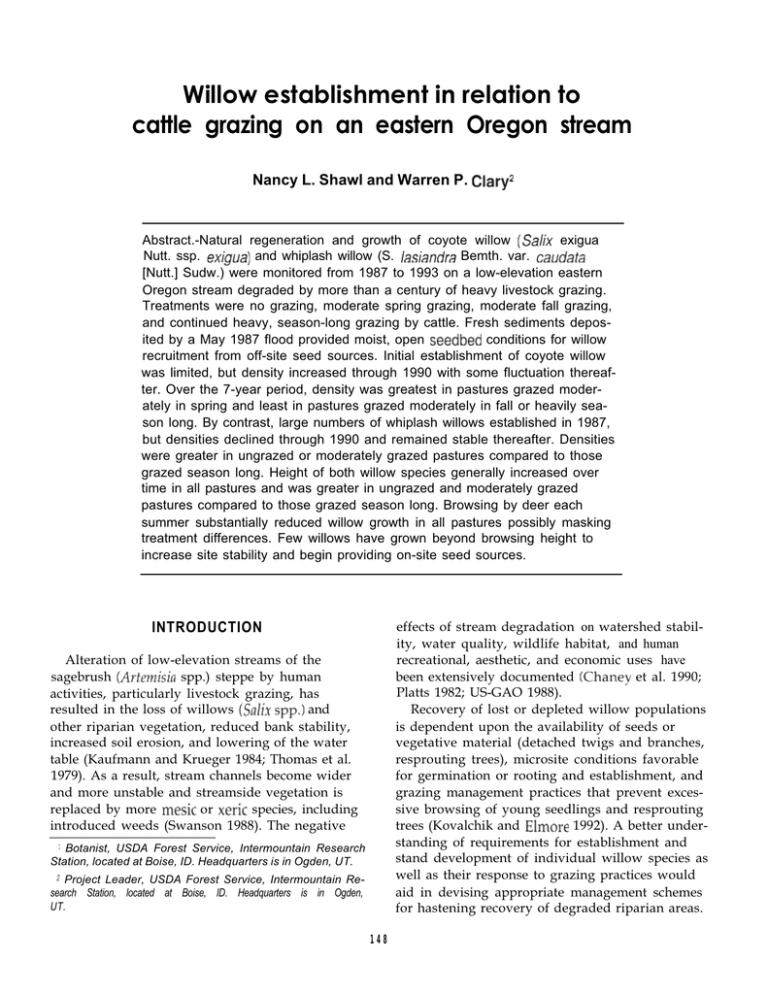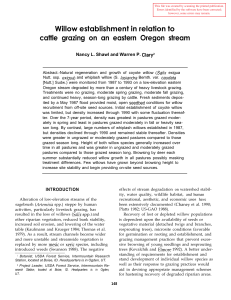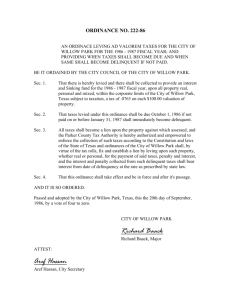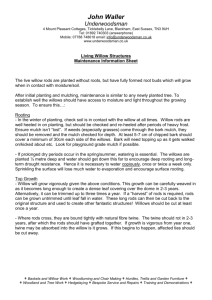Willow establishment in relation to Nancy L. Shawl and Warren P.
advertisement

Willow establishment in relation to cattle grazing on an eastern Oregon stream Nancy L. Shawl and Warren P. Abstract.-Natural regeneration and growth of coyote willow exigua and whiplash willow (S. Bemth. var. Nutt. ssp. [Nutt.] Sudw.) were monitored from 1987 to 1993 on a low-elevation eastern Oregon stream degraded by more than a century of heavy livestock grazing. Treatments were no grazing, moderate spring grazing, moderate fall grazing, and continued heavy, season-long grazing by cattle. Fresh sediments deposited by a May 1987 flood provided moist, open conditions for willow recruitment from off-site seed sources. Initial establishment of coyote willow was limited, but density increased through 1990 with some fluctuation thereafter. Over the 7-year period, density was greatest in pastures grazed moderately in spring and least in pastures grazed moderately in fall or heavily season long. By contrast, large numbers of whiplash willows established in 1987, but densities declined through 1990 and remained stable thereafter. Densities were greater in ungrazed or moderately grazed pastures compared to those grazed season long. Height of both willow species generally increased over time in all pastures and was greater in ungrazed and moderately grazed pastures compared to those grazed season long. Browsing by deer each summer substantially reduced willow growth in all pastures possibly masking treatment differences. Few willows have grown beyond browsing height to increase site stability and begin providing on-site seed sources. INTRODUCTION effects of stream degradation on watershed stability, water quality, wildlife habitat, and human recreational, aesthetic, and economic uses have been extensively documented et al. 1990; Platts 1982; US-GAO 1988). Recovery of lost or depleted willow populations is dependent upon the availability of seeds or vegetative material (detached twigs and branches, resprouting trees), microsite conditions favorable for germination or rooting and establishment, and grazing management practices that prevent excessive browsing of young seedlings and resprouting trees (Kovalchik and 1992). A better understanding of requirements for establishment and stand development of individual willow species as well as their response to grazing practices would aid in devising appropriate management schemes for hastening recovery of degraded riparian areas. Alteration of low-elevation streams of the sagebrush spp.) steppe by human activities, particularly livestock grazing, has resulted in the loss of willows and other riparian vegetation, reduced bank stability, increased soil erosion, and lowering of the water table (Kaufmann and Krueger 1984; Thomas et al. 1979). As a result, stream channels become wider and more unstable and streamside vegetation is replaced by more or species, including introduced weeds (Swanson 1988). The negative Botanist, USDA Forest Service, Intermountain Research Station, located at Boise, ID. Headquarters is in Ogden, UT. Project Leader, USDA Forest Service, Intermountain Research Station, located at Boise, ID. Headquarters is in Ogden, UT. 148 Coyote willow Nutt. ssp. whiplash willow Benth. var. are two early seral willow species common to riparian areas of the sagebrush steppe. Both willows rapidly colonize recent alluvial deposits. Their roots and shoots stabilize streambanks and dissipate flood energy. Stands persist on frequently flooded sites, but may be shaded out by later seral species on stabilized sites. Coyote willow is a short-lived, normally species that forms dense clonal thickets by development of shoots from buds on lateral roots (Argus 1973). It is highly tolerant of flooding and may occur below the high water line and Johnson 1985). Whiplash willow ranges in growth habit from multistemmed shrubs to like forms. It resprouts following crown removal, but does not spread by suckering (Argus 1973; Haeussler and Coates 1986; Zasada 1986). The objective of this study was to measure establishment and development of coyote willow and whiplash willow in response to season and intensity of cattle grazing on an unstable stream in the sagebrush steppe of eastern Oregon. The study was conducted in cooperation with the Bureau of Land Management, Vale District, local permittees, and landowners. bluegrass (Artemisiu habitat type is restricted to rocky, basalt sites with shallow soils. Season of use for the Poall Creek grazing allotment is April 1 to September 30 in even years and July 1 to October 31 in odd years Pole Creek is spring-fed and perennial with a 2.5 to 3 percent gradient and a uniform flow of about 0.03 Loss of native bank-stabilizing riparian vegetation as a result of livestock grazing practices has resulted in downcutting, in some cases to bedrock. Incised banks 1 to 3 m or more in height border a narrow floodplain, generally ranging from about 10 to 30 m in width. Unstable sandbars are initially colonized by species of horsetail spp.) and speedwell Sediments on low banks and terraces support Kentucky bluegrass and creeping communities. bentgrass Drier benches supporting exotic weeds grade into the sagebrush community. A limited description of the area provided by Peck and remnant plants, logs, and seedlings suggest woody riparian communities present pregrazing have included coyote willow, whiplash willow, leaved cottonwood James), and black cottonwood T. Remnant shrubs associated with the riparian area include blueberry elder Wood’s rose (Rosa woodsii and common chokecherry METHODS Study site Grazing treatments and willow recruitment and growth The study site elevation 880 to 975 is located on Pole Creek (Poall Creek) in the eastern foothills of the Cottonwood Mountains, Malheur County, Oregon. Climate is semiarid. Annual temperature at Vale, Oregon, the nearest reporting station, is 10°C; ranging from -3°C in January to 23°C in July. Annual precipitation is 244 mm with 61 percent falling from October through March (USDC-NOAA 1986-1993). Soils are derived from basalt and rhyolite, ranging from shallow and rocky on ridges to deep alluvial deposits in former wet meadows and sandy to gravelly deposits along stream channels. Uplands are steep (25 to 45 percent slopes) and support a Wyoming big (Artemisiu Nutt. [Beetle A. Young] S. L. Welsh/ var. L.) biotic climax. A stiff Eight pastures ranging from 3.7 to 8.9 ha in size were installed along a 5-km segment of Pole Creek in 1987. Five grazing treatments were applied from 1987-1993 in a completely randomized design with two replications. Four of these treatments are discussed here: season-long grazing, heavy to very heavy use; spring grazing, light-to-moderate use; fall grazing, light-to-moderate use; and protection from grazing pastures). All pastures except those grazed season long were fenced to exclude livestock, but not big game. Pastures grazed season long were located approximately 0.5 km from the nearest fenced pastures to avoid a water gap concentration effect in their use and were grazed with the remainder of the allotment. Spring 149 450 (early May) and fall (early October) grazing treatments were normally applied by releasing 4 cow/ calf pairs into each pasture for about 10 days. Treatment duration was determined by monitoring forage utilization by weight at streamside, primarily in Kentucky bluegrass and creeping bentgrass communities. Over the period of study, cattle use was 70 percent in pastures grazed season long, 21 percent in spring-grazed pastures, 42 percent in fall-grazed pastures, and 8 percent in protected pastures and Shaw 1994). Willow recruitment and growth were evaluated annually in early October 1987-93. In each pasture, twenty 5-m wide belt transects were placed perpendicular to the stream, spanning the corridor of stream-affected vegetation. Species, height, number of basal stems, distance from water, understory vegetation, substrate, and use by livestock or wildlife were determined for each willow occurring within the transects. Transect length and width of active and slack water were also recorded. Precipitation was measured at Brogan, OR, 3 km southeast of the study site. 400 . 1987 1988 1989 1990 Brogan 1991 1992 1993 Term Average Figure 1. Annual precipitation 1987-1993, Brogan, OR and long-term precipitation, Vale, OR. area. Willows present consisted almost entirely of small, heavily-browsed plants. Scattered producing willows were noted downstream with the nearest plant, a whiplash willow, about 0.5 km below the lowest pasture. Additional sources may be available in the head of the watershed, several kilometers above the pastures. A few willows within the pastures began producing seed by 1990. Throughout the study, willow seedlings occurred almost exclusively on saturated sediment surfaces free of vegetative competition, sediments supporting horsetail and speedwell species, and in slack water. Scattered willows were observed along dry channels or in Kentucky bluegrass communities. In October 1993, about 95 percent of all willows were less than 1.6 m from active water. Willow density fluctuated over time with contrasting trends developing for the two species (fig. Though establishment of coyote willow seedlings was limited in 1987, their density increased through 1989 and generally remained stable through 1993. Over the period, density in spring-grazed pastures exceeded that in grazed pastures or in pastures grazed season long. By contrast, large numbers of whiplash willow seedlings emerged in 1987, possibly due to a combination of seed availability and the presence of extensive fresh sediment surfaces deposited following a high-intensity rain storm in May, just prior to seed dispersal. Density of whiplash willow Statistical analysis For each willow species, plant density and growth data were compared among treatments and years using a two-way, repeated-measures analysis of variance. A two-way analysis of variance was used to compare basal stem numbers and distance from water among treatments and between species for 1993 data. Fisher’s Least Significant Difference was used to separate means where appropriate. All differences reported are significant at Standard errors are provided as a measure of variability around means presented in the text. RESULTS Dry conditions prevailed during 1987 to 88 and 1990 to 92 with Brogan precipitation ranging from 165 to 201 mm (fig. 1). Greater precipitation fell in 1989 and 1993. Although spring runoff did not produce major flooding during the study period, high-intensity, short-duration storms occurred in May and 1991 and August 1987 and 1990. Prior to initiation of the study, no mature, producing willows were found within the study 150 DISCUSSION AND CONCLUSIONS generally declined through 1990, remaining stable thereafter. Ungrazed and moderately grazed pastures supported greater seedling densities than pastures grazed season long. Height of both willow species has gradually increased over time, with the greatest increase occurring in 1993, an unusually wet year (fig. 2). The increase occurred even though all pastures, even those not grazed by cattle, receive heavy browsing by mule deer hemionus Rafinesque). Over the 7-year period, seedling height was greater in ungrazed or moderately grazed pastures compared to pastures grazed season long. In 1993, number of basal stems per plant was with no differences among treatments or between species. Trends in willow recruitment and establishment were complicated by factors uch as natural variability within and among pastures, effects of periodic high-intensity rainstorms, seed availability, and use deer in all pastures. Seed germination and establishment of willows depend on a series of stochastic events. Seeds are dispersed by wind and water and remain viable for only a short period; thus only those that are quickly dispersed to suitable microsites will germinate. Saturated sediment deposits left by flooding provide the light and moisture conditions required for germination and emergence of coyote and whiplash willow. Although flooding resulting from willow willow Effect 0.02 P= 0.02 P= 0.98 0.04 0.01 0.31 a 1.2007 sw- d ab a b b I 1 so 0.05 0.00 p= 0.00 p= 0.43 p= Figure 2. Density and height of coyote willow and whiplash willow in 1987-1993 for cattle grazing treatments at Pole Creek. Years followed by the same uppercase letter do not differ Treatment lines followed by the same lowercase letter do not differ 151 intensity summer storms during this study may have provided sediments for willow germination, small seedlings were also buried or uprooted by such events. Cattle use in grazed pastures and browsing by deer in all pastures has severely restricted willow establishment and growth. Kovalchik and (1992) reported that first-year willow seedlings are sensitive to cattle grazing and often killed as a result of uprooting or trampling. The rapid increase in height noted for all pastures in 1993 was likely related to good growing conditions occurring throughout the cool, moist summer and possibly a dilution of browsing pressure in the riparian area by favorable forage conditions elsewhere. By 1993, however, only percent of all willows exceeded 1.5 m in height. Crowns of plants reaching this height are not easily browsed and develop rapidly. Ability of willows to grow out of reach of browsers is essential for recovery. Healthy willows can achieve shoot and root sizes and densities needed to trap sediments and improve stream stability. The trapped sediments, in turn, provide suitable microsites for other riparian vegetation. Reduced cattle grazing or protection from grazing over a larger portion of the Pole Creek watershed might permit recovery of riparian vegetation to begin over a larger area, diluting deer browsing pressure to the point that willow seedlings could become established and grow beyond the reach of wildlife and livestock (Briggs et al. 1994). Due to the preponderance of exotic herbaceous species along the stream, recovery of native grasses, grasslike species, and forbs could be extremely slow. Spot plantings of native ceous species and more extensive plantings of shrubs associated with riparian areas may be necessary to speed the recovery of native species. Brunsfeld, Steven J.; Johnson, Frederic D. 1985. Field guide to the willows of east-central Idaho. Bull. 39. Moscow, ID: University of Idaho. 95. Wayne; Platts, William S. Chaney, Ed W.; 1990. Livestock grazing on western riparian areas. Produced for the U.S Environmental Protection Agency by the Northwest Resource Information Center, Inc. Eagle, ID. Denver, CO: U.S. Environmental Protection Agency. 45. Clary, Warren P.; Shaw, Nancy L. 1994. Response to grazing control by an unstable riparian system. In: Northwest regional riparian symposia: Diverse values: seeking common ground; 8-9 December 1994; Boise, ID. Moscow, ID: University of Idaho, Idaho Water Resources Research Institute, Idaho Riparian Cooperative: 96-101. Haeussler, S.; Coates, D. 1986. Autecological characteristics of selected species that compete with conifers in British Columbia: a literature review. Victoria, B.C.: Canadian Ministry of Forests, Information Services Branch. 180. Kaufmann, J. Boone; Krueger, W. 1984. Livestock impacts on riparian ecosystems and streamside management implications. a review. Journal of Range Management. Kovalchik, Bernard L.; Wayne. 1992. Effects of cattle grazing systems on dominated plant associations in central Oregon. In: Clary, Warren E. Durant; Bedunah, Don; Wambolt, Carl L., compilers. Proceedings-symposium on ecology and management of riparian shrub communities; 1991 May 29-31; Sun Valley, ID. Gen. Tech. Rep. INT-289. Ogden, UT: U.S. Department of Agriculture, Forest Service, Intermountain Research Station: 111-119. Peck, Morton E. 1911. Summer birds of Willow Creek Valley, Malheur County, Oregon. The Condor. 63-69. Platts, William S. 1982. Livestock and riparian fishery interactions. What are the facts? Transactions of the 47th North American Wildlife and Natural Resources Conference. 47: 507-515. Swanson, Sherman. 1988. Using stream classification to prioritize riparian rehabilitation after extreme events. In: Dana L., tech. Proceedings of the California riparian systems conference: protection, management, and restoration for the 1990’s; 1988 September 22-24; Davis, CA. Gen. Tech. Rep. PSW-110. Berkeley, LITERATURE CITED Argus, George W. 1973. The genus in Alaska and the Yukon. Pub. Botany 2. Ottawa, Ontario: National Museums of Canada, National Museum of Natural Sciences. 279. Briggs, Mark K.; Roundy, Bruce A.; Shaw, William W. 1994. Trial and error: assessing the effectiveness of riparian revegetation in Arizona. Restoration Management Notes. 160-167. 152 United States Department of the Interior, Bureau of Land Management, Vale District. 1982. Poall Creek Allotment Management Plan 0103. Unpublished paper on file at: U.S. Department of Agriculture, Forest Service, Intermountain Research Station, Forestry Sciences Laboratory, Boise, ID. n.p. United States Department of the Interior, Bureau of Land Management, Vale District. 1987. Poall Creek Allotment Evaluation. Unpublished paper on file at: U.S. Department of Agriculture, Forest Service, Intermountain Research Station, Forestry Sciences Laboratory, Boise, 3 Zasada, John. 1986. Natural regeneration of trees and tall shrubs on forest sites in interior Alaska. In: Van Cleve, K.; F. Stuart III; Flanagan, P. W.; [and others], eds. Forest ecosystems in the Alaska taiga: a synthesis of structure and function. N.Y.: Springer-Verlag: 43-73. CA: U.S. Department of Agriculture, Forest Service, Pacific Southwest Forest and Range Experiment Station: 96-101. Thomas, Jack W.; Maser, Chris; Rodiek, Jon E. 1979. Wildlife habitats in managed rangelands the Great Basin of southeastern Oregon. Zones. Gen. Tech. Rep. PNW-80. Portland, OR: U.S. Department of Agriculture, Forest Service, Pacific Northwest Forest and Range Experiment Station. 18. United States Department of Commerce, National Oceanic and Atmospheric Administration. 19861993. Climatological data Oregon. Vols. 92-99. U.S. Department of Commerce, National Oceanic and Atmospheric Administration, National Climatic Data Center. n.p. United States General Accounting Office. 1988. Public rangelands: some riparian areas restored but widespread improvement will be slow. GAO/RCED-88-105. Gaithersburg, MD: U.S. General Accounting Office. 85. 153






